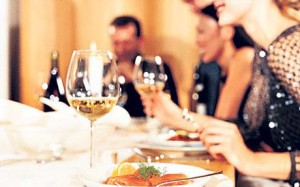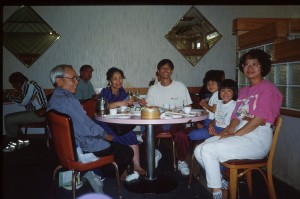THE MESSAGE IN THE MIDNIGHT MEAL
Can shared fare at the witching hour heal body, mind, and soul?
— By Deborah Kesten —
One morning while reading an article in a local newspaper, I found myself riveted by a piece titled “Midnight Supper: Spontaneous Party at the Witching Hour.” Written by Lois Maclean, a then-unemployed, forty-something woman, “Midnight Supper” is a story about something very unusual that happened to her and her husband at 10:30 on a depressing Tuesday night. As they were considering whether to go “into a full-tilt harangue about everything that was wrong with [their] life,” they received a phone call from Bradley, an old friend who had recently wed a woman from Hong Kong named Suk Wah; Brad was calling to invite them over for a midnight supper at a villa where he and Suk Wah were house-sitting.
Although Maclean and her husband were “awed by the very concept,” taking their friend up on the invitation meant a half-hour drive at 11:00 on a weekday night across the long Richmond Bridge in Northern California. They went anyway. As Maclean described it: “We threw on our jackets and hit the freeway, already feeling more interested in life.”1
Ancient “Ingredients” in the Midnight Meal
 When Maclean and her husband entered the villa, she described the spontaneous, warm and welcoming hospitality that greeted them: “Bradley and Suk Wah handed us…flutes of champagne from their wedding,” says Maclean. Then the main meal manifested: “At a cluttered table in the bright kitchen, we dispatched a giant bowl of Suk Wah’s Chinese spaghetti, fragrant with ginger and dried shitake mushrooms. Afterward, we curled up with cups of herb tea.”
When Maclean and her husband entered the villa, she described the spontaneous, warm and welcoming hospitality that greeted them: “Bradley and Suk Wah handed us…flutes of champagne from their wedding,” says Maclean. Then the main meal manifested: “At a cluttered table in the bright kitchen, we dispatched a giant bowl of Suk Wah’s Chinese spaghetti, fragrant with ginger and dried shitake mushrooms. Afterward, we curled up with cups of herb tea.”
Explained Suk Wah as she handed around the teacups: “Midnight supper is a Chinese custom. We celebrate the magic of the night.”
Suk Wah’s idea to share a midnight meal with friends has lots of company. For thousands of years—over hundreds of generations— human beings have enjoyed the ritual of communing with each other over food. Indeed, if our ancestors’ past contains a single culinary theme, it’s uniting with others through food (see “Study Uncovers 6 Ancient Healing Secrets of Food” and “Eat with Others, Weigh Less”).
A sampling…
- Christians take the bread and wine of the Eucharist in communion with others, and on Sundays after church, often share a meal with other congregants.
- On the Jewish Sabbath, a holy 24-hour period that’s been celebrated by Jews since biblical times, devout Jewish families make it a point to stop the hustle and bustle of the week on Friday before sunset and instead partake of the Sabbath meal with family members and friends.
- Believing that the blessing received isn’t only the food but also the company, Muslims espouse both eating with others and sharing food with others. A unique social concept: the aroma of food while it cooks should encourage neighbors to come by and share the meal.2
The centuries-old food-friendship connection has been so integral to humankind’s eating experience, it was what inspired Suk Wah’s midnight meal. When I talked with her, I learned that her idea to “celebrate the magic of the night” with friends evolved from New Year rituals she had celebrated with her family during her childhood in Hong Kong. “China’s ancient folk religion has a god for just about everything,” she told me,” and on the eve of the Chinese New Year, all of them come to inspect us.”1
By preparing a special midnight meal, the family welcomes both these hundreds of gods and the New Year by gathering around and sharing an elaborate midnight meal. It is a truly festive family occasion; one that has nourished family and friends for millennia…no matter where they are in the world.
The Healing Ingredients in Shared Fare
Caption: 3-generation family having breakfast in San Francisco’s Chinatown
 Along with its inherent uniqueness, what particularly caught my attention about Suk Wah’s spontaneous midnight meal was the impact it had on Maclean’s mood and mental state. Before the meal, she had been in a curmudgeon-y frame-of-mind about her life. But the social connection over a simple meal was so soul-satisfying, she and her husband “went home at around two in the morning, sated with simple food and simple kindness, our malaise dispelled. When we awoke in the morning, we felt…tired but satisfied, refreshed and a lot lighter of heart.”1
Along with its inherent uniqueness, what particularly caught my attention about Suk Wah’s spontaneous midnight meal was the impact it had on Maclean’s mood and mental state. Before the meal, she had been in a curmudgeon-y frame-of-mind about her life. But the social connection over a simple meal was so soul-satisfying, she and her husband “went home at around two in the morning, sated with simple food and simple kindness, our malaise dispelled. When we awoke in the morning, we felt…tired but satisfied, refreshed and a lot lighter of heart.”1
Social connection. Simple food. Kindness. Dispelled dissatisfaction. When a meal is infused with such social “ingredients,” some kind of healing alchemy seems to be set into motion. Three “social studies” about the healing power of food and friendship (which we call “social nutrition“) may provide some clues about the well-being Maclean experienced from her friendship-infused meal.
Social ties. The idea that eating in a socially supportive atmosphere can serve as a buffer against ailments emerged in a landmark 25-year study that began in the early 1960s in the small town of Roseto, Pennsylvania. It was then that a local physician told researcher Stewart Wolf that he rarely saw cases of heart disease in the town’s Italian-American population—even though they consumed a traditional high-fat, high-cholesterol Italian-American diet of sauces, sausages, and other food deemed to be artery-clogging. What did Wolf find after studying Rosetans for 25 years? When the study started, close family ties and community cohesion were the norm; it was common to find three generations living together in one home. But as the children became adults, they moved away from Roseto. Over time, the close-knit way of life that had united Rosetans since their migration to Roseto had first migrated to America in 1882 had ended—along with its prophylactic effect on heart disease.3
Care-filled feeding. When researcher Robert M. Nerem set out to learn about the effect diet has on the development of coronary artery disease (CAD), a research assistant on his team fed high-cholesterol bits of rabbit chow to caged rabbits. Though all the rabbits were fed the same artery-clogging food, some of them had 60 percent less plaque (blockage) in their arteries. Unable to understand why some rabbits showed early signs of heart disease and others didn’t, Nerem realized that when the research assistant fed the rabbits in the middle cages, she would take them out of their cages to hold, pet, talk to, and play with during feeding; these were the ones that were less prone to clogged arteries. When the scientists repeated the study under much more measured conditions, again, the cared-for rabbits showed more than a 60 percent reduction in lesions compared to the comparison group, even though the serum cholesterol levels, heart rate, and blood pressure of all the rabbits were similar.4
Solo dining. More often than not, an eat-alone dining scene plays out daily for millions of Americans: children reach for a piece of packaged pizza, then eat it at the computer; single working women heat up their frozen meal in the microwave, then dine solo while watching TV; while others are driven to dashboard dining in their cars while en route to a meeting. Such “solo dining” emerged in our research, which linked eating alone more often than not with an increased likelihood of being overweight or obese. Indeed, the more often people dine alone, the higher their body mass index (BMI), which is the measure for weight levels. In contrast, we found that normal weight people typically eat with others.5,6
The Message in the Midnight Meal
The physical and emotional well-being Maclean experienced after her midnight meal, and the Roseto, rabbit, and solo dining studies suggest that…somehow…the “social consciousness” we bring to meals matters to our health and well-being. Physician Deepak Chopra explains the powerful, invisible nutrients inherent in “shared fare” this way: “When you look at nutrition from a purely scientific point of view, there is no place for consciousness. And yet, consciousness could be one of the crucial determinants of the metabolism of food itself.”7,2 (See “Stress More, Eat More” for more about how thoughts and feelings (meaning, “consciousness”) while eating, affect digestion, weight, and more.)
Such inspirational ideas beg this question: Might the meal shared with loving friends be the reason Lois Maclean turned the doldrums she was experiencing at the start of her journey to her friends’ midnight meal, into feeling, instead, “lighter of heart” when she returned home? If so, perhaps the message in the midnight meal is that it is one thing to eat; it is another to dine on lovingly prepared food with good friends. For when we do, not only is our appetite nourished, but body, mind, and soul too are satisfied.
References:
- Deborah Kesten, The Healing Secrets of Food: A Practical Guide for Nourishing Body, Mind, and Soul (Novato, CA: New World Library, 2001).
- Deborah Kesten, Feeding the Body, Nourishing the Soul: Essentials of Eating for Physical, Emotional, and Spiritual Well-Being (Berkeley, CA: Conari Press, 1997; Amherst, MA: White River Press, 2007).
- Julie Stewart Wolf and John G. Bruhn, The Power of Clan: The Influence of Human Relationships on Heart Disease (New Brunswick, NJ: Transaction, 1993).
- Robert M. Nerem, Murina J. Levesque, and J. Fredrick Cornhill, “Social Environment as a Factor in Diet-Induced Atherosclerosis,” Science New Series 208, no. 4451 (1980): 1475–76.
- Deborah Kesten and Larry Scherwitz, Make Weight Loss Last: 10 Solutions That Nourish Body, Mind, and Soul (Amherst, MA: White River Press, 2012).
- L. Scherwitz and D. Kesten, “Seven Eating Styles Linked to Overeating, Overweight, and Obesity,” Explore: The Journal of Science and Healing 1, no. 5 (2005): 342–59.
- Deepak Chopra, Body, Mind and Soul, PBS, KQED-TV, San Francisco, March 7, 1995.
Related:
“Eat with Others, Eat Less”
“The Weight Loss Wonder of When You Eat”
“The ‘Magic Sleep Number’ for Weight Loss”
“Night Eating: A Triple Weight-Whammy”
Next post:
Think outside the diet to make weight loss last with “Seasonal Food Fables: A 4-Part Personal Memoir” posted on our FreshFoodFables blog.
SHARE and LIKE us on Facebook, follow us on Twitter, or send us an email.
Comments:
What are your thoughts about “The Message in the Midnight Meal?” Tell us about them in the Comments section below.



